Flabellina verrucosa
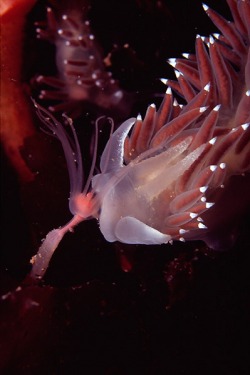
Flabellina verrucosa is perhaps the most visible of all nudibranchs found in New England. It grows to approximately 1.33 inches long and is quite common. The cerata can range from red to a chocolate brown. It feeds upon various species of Tubularia hydroids as shown in this photograph taken in Eastport, Maine.
Flabellina pellucida
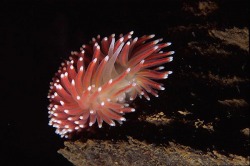
Flabellina pellucida grows to approximately 1.25 inches in length but usually a bit smaller. It is distinguished by the larger number of crimson red, white-tipped cerata found along its back. It feeds upon both Eudendrium and Tubularia hydroids. This one was photographed pn an old pier piling at approximately 35 feet in Eastport, Maine.
Flabellina gracilis
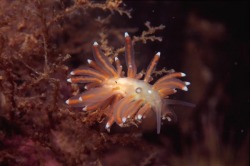
Flabellina gracilis is the smallest of the "Red-gilled Nudibranchs" found in New England waters. It grows to 0.5 inches long but is usually seen at about 0.25 inches. Many who see this nudibranch think they are looking at a juvenile Flabellina verrucosa. The cerata are normally orange to a bright crimson red. It feeds upon Eudendrium hydroids.
Flabellina species
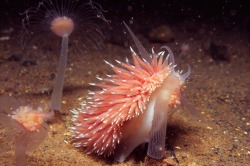
This large nudibranch is found on sandy bottoms where it feeds and lays its eggs on large solitary hydroids, Corymorpha pendula. No scientific name has been officially provided for this large species. It is a fast growing nudibranch which over a period of a few weeks in the summer grows exponentially in size, reaching about 2 inches. This photograph was taken in Eastport, Maine during August.
Flabellina salmonacea
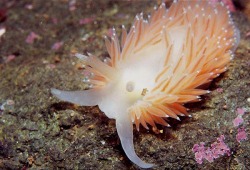
Flabellina salmonacea grows to just over 1.5 inches long. It has numerous cerata that are colored either brown or orange depending on type of prey. The orange color is is due to a diet consisting of burrowing and Goniactinia anemones. Most often encountered is the brown version which feeds upon ascidians. This specimen was photographed off Deer island, New Brunswick, Canada across from Eastport, Maine.
Aeolidia papillosa
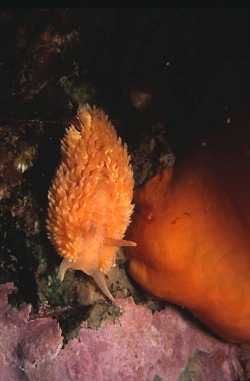
Aeolidia papillosa is the largest nudibranch in New England waters. Most large specimens are approximately 2.75 inches long, sometimes larger. Its common name is the Maned Nudibranch. It varies in color with mottled shades of white, brown and orange being most common. The Frilled Anemone, Metridium senile, is the prey of A. papillosa. A good strategy in finding A. papillosa is to look for around anemones which have retracted their tentacles in an area where many anemones have their tentacles exposed. The retraction of the tentacles is a response to an attack by A. papillosa. The other response is to sting A. papillosa with sticky white defensive threads called acontia which contain stinging cells. This specimen was photographed at Folly Cove in Gloucester, Massachusetts.
Cuthona concinna
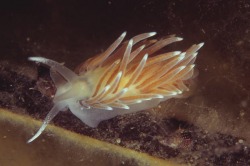
Cuthona concinna is usually described as drab looking with a pale yellowish coloration. It grow to approximately 0.5 inches long. Its preferred prey are colonial hydroids. The specimane was photographed in Woods Hole, Massachusetts.
Cuthona gymnota
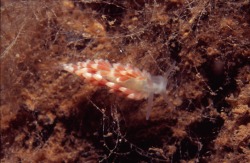
Cuthona gymnota is a fairly common nudibranch that reaches a size of approximately 0.75 inches but is typiacally smaller. It feeds upon Tubularia hydroids where it derives much of its coloration. Like E. tricolor this nudibranch feeds not from the top of the hydroids but from the base. The specimen was photographed in Eastport, Maine.
Cuthona pustulata
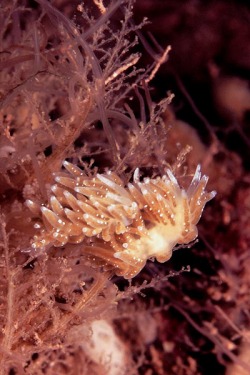
Cuthona pustulata is easily recognized from the white patches found on its cerata. The cerata may are generally a dull brown or yellowish as seen with the pair in the photograph. C. pustulata grows to approximately 0.5 inches long but is generally encountered at smaller sizes. It feeds upon hydroids such as those in the photograph taken in Eastport, Maine.
Eubranchus tricolor
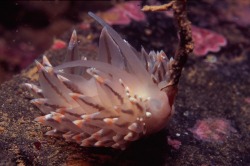
This species is somewhat unique as it feeds not on the feathery top of hydroids but on the stalks of the hydroids, typically Tubularia spectabilis, as shown in this photograph. Eubranchus tricolor can reach a length of 1.25 inches. This photograph was taken at a depth of approximately 45 feet in Eastport, Maine
Eubranchus pallidus
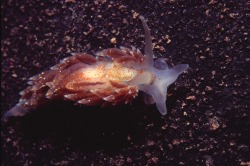
Eubranchus pallidus is typically less than 0.5 inches long but can grow a bit larger. It is generally tinted orange with flecks of color along its body. The cerata are quite often inflated. The individual pictured was a larger specimen and was crawling along a discarded tire in the waters of Eastport, Maine
Eubranchus olivaceous
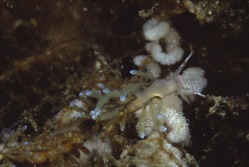
Eubranchus olivaceous is a rather small nudibranch reaching only 0.25 inches in length. It feeds on colonial hydroids such as Obelia commisularis. Finding this species is easy as its egg masses are very bright white and are often numerous on the hydroids it feeds upon. This one was photographed in Woods Hole, Massachusetts.
Okenia ascidicola
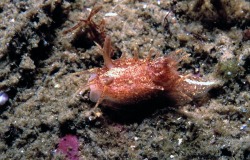
Okenia ascidicola is a difficult nudibranch to find. It is a reddish brown color with yellow speckles. It reaches a maximum length of just about 0.5 inches. One would think that a reddish nudibranch with yellow speckles would be a bit conspicuous and it is if you encounter it out and about. However this nudibranch spends most of its time hiding inside the tunicates it feeds upon. It was first discovered in 1968 near Nahant, Massachusetts. The one in the photograph was found at Folly Cove in Gloucester, Massachusetts. Finding the curled, cork screw shaped egg mass of O. ascidicola is a hint that they are about and not hiding in a tunicate.
Thecacera pennigera
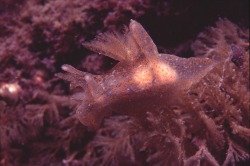
Thecacera pennigera is an invader in New England waters. It is found nearly worldwide and it is known for its hitchhiking to new areas. The species was first reported in New England from Woods Hole, Massachusetts. It feeds on bryozoans which can be seen in the photograph.
